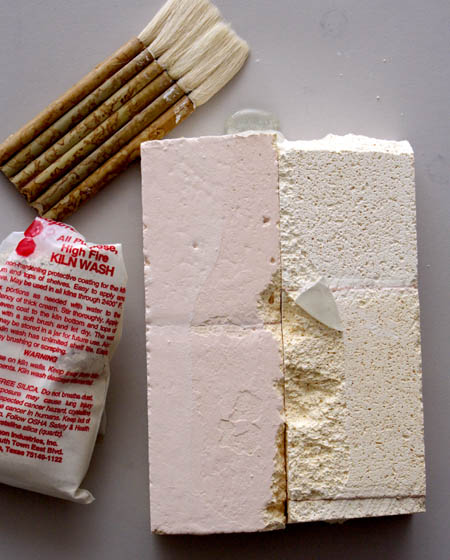 |
|
|
Kiln Pointers
|
|
|
An Experiment with Kiln Wash on Firebricks |
A glass artist recently overfired her kiln. She was slumping glass bottles. The kiln overfired while she was away, and glass dripped over the edges of the kiln shelf onto the firebrick bottom. After the kiln cooled, she opened the lid and found splotches of glass embedded into the firebrick bottom. She thought her beautiful kiln was ruined. But after reviewing a picture she sent, I assured her that the damage was minor. (Near the end of this message, I’ve included instructions for removing embedded glass from firebricks.) I asked her if she had coated the firebrick bottom with kiln wash. She said no. She had heard that it wasn't necessary in firing glass. So I decided to experiment with kiln wash, which is a finely ground powder that mixes with water. At high temperatures, the kiln wash does not fuse. Thus, it acts as a barrier against melting ceramic glaze or glass. For my experiment, I found two scrap firebricks in the Paragon factory and coated one with kiln wash. I left the other bare. I placed the two bricks side by side on a kiln shelf in a Paragon Fusion-10 glass kiln. Then I laid a clear glass bottle across the two bricks and fired the kiln to 1700 degrees F with a one-hour hold at the end of the firing. I checked the Fusion-10 from time to time. Through the peephole I could see the glass turn red, bright orange, and then yellow. It sagged and finally flattened against the firebricks. The next morning I opened the lid. The overfired glass bottle was now an ugly melted blob. To remove the glass from the bare firebrick, I had to dig it out with a screwdriver. A 1/4”-layer of brick adhered to the glass. But the surface of the kiln-washed firebrick remained smooth. The only particles that adhered to the glass were from the side of the brick where I had not applied kiln wash. SUMMARY 1) Coat the firebrick bottom of your kiln with kiln wash. Do this even if you are firing only glass and feel that you will never overfire your kiln. For kilns rated over 1700 degrees F, the kiln wash must be rated to 2400 degrees F. 2) Pour a little water into a disposable container and add powdered kiln wash until it has the consistency of coffee cream. Stir until lumps dissolve. 3) Apply three thin layers of kiln wash rather than one thick layer. You can use a small paintbrush, but I prefer the haik brush, because it applies a smooth coat and holds a large amount of kiln wash. Allow the kiln to dry before firing. 4) To avoid dust, vacuum the kiln frequently. Use a brush nozzle on a vacuum cleaner. (By the way, avoid breathing the dust.) 5) If the kiln wash cracks or flakes off, reapply it only to the bare spots. Do not remove the kiln wash from the firebrick bottom and apply a fresh coat. This is unnecessary and very messy. 6) Avoid splashing kiln wash onto the firebrick walls, especially if you have sidewall elements. Kiln wash and glass separator destroy elements, so keep the bag of powder sealed. 7) Do not apply kiln wash to ceramic fiber firing chambers. Kiln wash is meant for firebricks and ceramic shelves. 8) If glass or glaze embeds into a firebrick bottom, the damage is often minor. Wearing protective gloves, remove the glass with a screwdriver. You can fill in the gouges with a 1:1 mixture of kiln cement and powdered firebrick. If the gouge is minor, I would not even repair it. Minor gouges in the bottom will not affect your firings as long as you have smooth areas to support kiln posts. 9) Do not leave your kiln unattended, especially near the end of the firing. 10) Leave the bottom uncoated if your kiln has an element in the bottom. Be careful not to drop dust onto that element. ON-LINE GLASS TECHNICAL POINTERS I have just added Bullseye Glass to Paragon’s list of website links: http://www.paragonweb.com/Links.cfm http://www.bullseyeglass.com/connection/education/ (Click on the above links, or go to www.bullseyeglass.com and click on Education.) Bullseye offers downloadable pdf files for glass artists: TechNotes 1: Knowing Your Kiln TechNotes 2: The Vitrigraph Kiln TechNotes 3: Compatibility of Glasses TechNotes 4: Heat & Glass TechNotes 5: Volume & Bubble Control TipSheet 1: Kilncarving TipSheet 2: Accessory Glasses TipSheet 3: Working Deep TipSheet 4: Design Your Own Art Glass TipSheet 5: Bullseye Box Casting TipSheet 6: The Amazing Roll-Up TipSheet 7: Platemaking You would think that firing kilns is routine for someone who works in a kiln factory. But it is not. I enjoy even test-firing a kiln. It reminds me of my 8th grade science class. With best wishes, Arnold Howard Paragon Industries, L.P. – Better Designed Kilns 2011 South Town East Blvd. Mesquite, TX 75149-1122 Voice: 972-288-7557 & 800-876-4328 / Fax: 972-222-0646 ahoward@paragonweb.com / www.paragonweb.com ------------------- Feel free to email this Kiln Pointer to friends. To read back issues Click here or go to www.paragonweb.com, select “Support,” and then “Kiln Pointers” from the drop menu. To respond to this Kiln Pointer, press Reply. Your email will go directly to Arnold Howard. Copyright 2006, by Paragon Industries, L.P. |
|
|

|
|
|
|
|
“Custom and standard Kilns and Industrial Furnaces for ceramics, pottery, heat treating, enameling, |
||||
